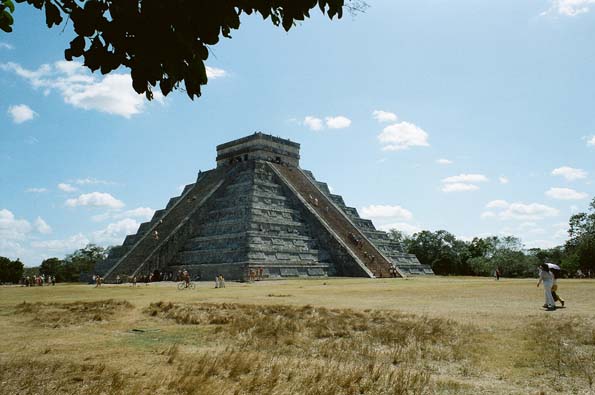Photos from the Philippines: Coron
{click on any image to see the full size version}
The website of Rene Navarro
{click on any image to see the full size version}
I was in the Philippines from February 14 to March 7, spending a few days in different places – Tarlac, my hometown, Manila and Coron.
Coron, Palawan, Philippines has become a more visible and popular destination, not only for the well-to-do but also for backpackers. There are a few expensive hotels and many hostels and room rentals. The overhead is manageable. There are also amenities that are free or low-cost.
I heard that Coron is going to be like Boracay in 5 to 10 years – overcrowded, noisy, commercial and expensive, dotted with condos and golf courses and not to forget, the ubiquitous videoke bars. Of which, I should mention that one time I woke up in Estipona, Pura, Tarlac at 2 in the morning I heard a distant voice from the next village singing a popular song … “I write a song” by … I can’t even remember the name of the famous singer. Senior moment, I guess. The thing is that Coron has several Islands, part of the Palawan province complex, including the iconic El Nido. You can visit any one of them, especially in this Year of the Water Snake. Coron Is Water Heaven. True, there will be heavy traffic in one or two islands and you may have to wait to dock your catamaran. But there are other islands to choose from. There is also a hot spring resort many backpacking young foreign couples repair to after 5 in the afternoon. Water temperature: 38 degrees C on the lower level and 42 degrees C on the upper level of the pool. There is an entrance fee in every island – for maintenance and upkeep – of about PhP 100 to 300 (about $2 to $5).
For those who love mythology and its lessons for us in life, we quote from two famous authors who put in historic and symbolical context some of our ancient images.
Mircea Eliade in his book “The Sacred and Profane: The Nature of Religion” has something to say about the waters:
The waters symbolize the sum of virtualities; they are fons et origo, “spring and origin,” the reservoir of all the possibilities of existence; they precede every form and support every creation … This is why the symbolism of the waters implies both death and rebirth. Contact with water always brings a regeneration – on the one hand because dissolution is followed by a new birth, on the other because immersion fertilizes and multiplies the potential of life.
Joseph Campbell in his book “The Power of Myth” says:
The power of life causes the snake to shed its skin, just as the moon sheds its shadow. The serpent sheds its skin to be born again just as the moon sheds its shadow to be born again. They are equivalent symbols. Sometimes the snake is represented as a circle eating its own tail. That’s an image of life. Life sheds one generation after another, to be born again. The serpent represents immortal energy and consciousness engaged in the field of time, constantly throwing off death and being born again. There is something tremendously terrifying about life when you look at it that way. And so the serpent carries with it the sense of both fascination and the terror of life.
I was with a medical mission from Pennsylvania, a group of mostly Filipino-American doctors who have done work in India, Uruguay, Thailand and the Philippines. Five years ago, I was the only acupuncturist in the group. I managed to do some treatments because a couple of doctors referred patients to me. This time around, I did not get any patients. When I applied to join the group, I told an organizer that I was an acupuncturist. She told me that I could carry their equipment. So even when a doctor told me that I should be in the hospital to await referrals, I stayed in the hotel and read and practiced Chinese calligraphy and meditated and did island-hopping one day. It was not the thing I came to do but hey, it was better than carrying luggage. I was told that there were more than 20 tubal ligations in one day. When a priest was told about it, he expressed shock that the procedure was being done in the hospital. Perhaps he had nothing to do with it, but the next day, only 2 or 3 women appeared for the surgery. The Reproductive Health Law was passed only recently in the Philippines. The Roman Catholic Church has been its main and strident opposition over the years. A wag remarked and only half-jokingly that the priests should be required to undergo vasectomy.
I have included photos from the old hometown, my Zhan Zhuang and Tai chi chuan DaoRen seminar and my evening with Palanca Literary Hall of Fame recipient Ed Maranan. Ed and I had a “sighting” of Imelda Marcos at the art exhibit of Joly Benitez and Jana, father and daughter, at the Erewhon Gallery. I knew Joly from the 60s when he worked for senator Helen Benitez (and later Imelda) and I for Senator Lorenzo Tanada, the famous Filipino nationalist and opposition leader. He did not recognize me when I was introduced to him. I did not recognize him either because he had become terribly emaciated. Jana told me that she studied wu-shu/contemporary Chinese martial arts in Wudang. I wanted to talk to her about it but she was too occupied at the time. Later, Ed and I joined a banquet with his family at Muang Thai, owned by Maranans. I can say here that their version of the cuisine is better than the restaurants I tried in Thailand!
Of course there are plenty of shots of Coron where I spent more than a week in idle rustication. There are photos of tamarind fruits and cashews both yellow and red. For those who do not know, cashews are probably the only trees with nuts outside the fruit. The fibrous fruit, usually dipped in salt, is sour and sweet and tangy. It is eaten raw or made into a juice. Coron is a prominent producer of cashew nuts. Aside from the cashew and tamarind, we had mangos and duhat, a black cherry that I have seen only in the Philippines. Perhaps they were transported to the Philippines from Mexico by the Spanish galleons during the Conquista. There were red snappers, clams, crabs, and shrimps for dinner. Fresh coconuts could be ordered anytime. I have no recommendations, but Sophia’s Garden Resort, where we stayed, was impeccable if a bit expensive, its staff were always thoughtful and friendly. There are a few island-hopping facilities offering tours. Ask for Al Linsangan. He is famous on the island. He has good credentials. One of our regrets: when we contracted a different outfit, we were slapped with hidden bills. Be sure to negotiate all the terms before paying because you may be asked to pay for undisclosed expenses.
I’ve featured Rose, our host and guide, who arranged one of our trips. She was a sparkplug. She knew everything and everybody. You have to learn to harness her because she can be very hyper. I’ve also photographed the hotel staff at Asia Grand View Hotel, where we had a few dinners, on our last day on the island.
One of the amusing surprises in Coron: I did not know any of the passengers on our island-hopping tour. While we were lunching at a nipa hut on one of the beaches, Maria formerly from Uruguay now living in Spain asked the young woman across the table, Why are people asking you to pose for pictures with them? The mother answered, She represented the Philippines in the Miss Universe Beauty Pageant in Las Vegas. We were told that she, Janine, won first runner-up. She looked simple, with that quiet, slim and unpretentious beauty of the Filipina from the back country. I did not know she was that important to the public until everybody who heard of my encounter was asking me to show my photos of her. So I had “sightings” of prominent women on this trip: Esperanza del Rosario, the widow of my former minister in the old hometown, whom I had not seen for more than 40 years (she attended my Zhan Zhuang and Tai chi chuan DaoRen seminar); Imelda, the notorious first lady of the dictator Ferdinand, who seems to make a good copy even now; and Janine (sorry I don’t have her last name), Binibining Pilipinas/Miss Philippines., whose morena image appears on several advertising billboards in Manila; and last but not least, Loida Nicolas Lewis, University of the Philippines. college of law contemporary (mid-60s), true friend, New Yorker and fellow anti-Marcos adherent. Loida is one of the strongest-willed and most generous and honest persons I know.
I would like to thank family and friends for their hospitality and INAM (ATRC), the NGO that runs a healing and acupuncture center and sponsored many of my seminars since 1998, and the indefatigable Annie Sollestre for organizing the seminar for me.
Ganbei!
Rene
{click on any image to see the full size version}
{click on any image to see the full size version}
{click on any image to see the full size version}
Hello,
Several years ago, I read “Journey to the West,” the Chinese epic about the monkey Sun Wukong and Tripitaka, the Buddhist monk. It is in four volumes. Now I am reading “Xuan Zang: A Buddhist Pilgrim on the Silk Road” by Sally Hovey Wiggins. Xuan Zang was the Buddhist monk who traveled to India in the 7th century CE to gather scriptures. It was a long journey through mountains, deserts, many kingdoms and tribes. He met kings, robbers, nomads, monks, spirits. I was reminded of the book “Ultimate Journey: Retracing the Path of an Ancient Buddhist Monk Who Crossed Asia in Search of Enlightenment” by Richard Bernstein. The book is still available at the Buddhism and religion section in the basement of Strand Books on 12th and Broadway in NYC. I wrote a review of it a decade ago that was never published anywhere. I am printing it here for the first time. There are a few photos from Xian that accompany the piece.
There are also a few more photos from Angkor Wat that I haven’t included before.
There’s a poem “Return” that is published here for the first time. It is from a collection of China poems. I wrote it in London.
I am traveling to the Philippines again on February 14. I won’t be back until March 7. It is mainly for a medical mission to Palawan, one of the islands in southern Philippines. But I am also teaching a seminar on Zhan Zhuang and Tai chi chuan DaoRen to be sponsored by INAM-ATRC, an NGO that has organized many of my seminars since 1998. The seminar scheduled for March 5 and 6 is a fund-raising for their indigent project. Look at my website for further announcements.
In my first medical mission in the island of Romblon, organized for western physicians 5 years ago, I did a few acupuncture treatments and taught the 6 Healing Sounds. The organizers did not really know what to do with me because they had not had any experience with acupuncture before. One treatment I did involved a man who could hardly walk without being supported by somebody. I did a Kiiko Matsumoto treatment on his leg and qigong on his spine. The medical mission involved surgeries under rather spartan conditions. A funny thing was that after a boy was circumcised, it looked like he told everybody else on the island and the very next day more than 100 boys showed up. The doctors did not know how to handle the situation partly because there were so many kids waiting but also because there were more important cases on the list. The doctors met for an urgent conference. One problem they talked about was what kind of circumcision was to be done? I told them that the prevailing technique in the Philippines was the dorsal cut, a very easy, quick procedure done with a razor blade by the local traditional native healer that won’t take too much time.
When I was in the Philippines December 25 to January 16 I attended the wedding of my youngest brother. The wedding was held at the local church. The mass solemnized by our uncle, Archbishop Tirona, was held in the backyard of their new home surrounded by 500 ylang-ylang trees that were just beginning to bloom. During my visit, my brother Roland and his wife Victoria took me and 4 other wedding guests — 3 from Miami, Florida, and 1 from Vietnam — on day trips to different places on Luzon, the main island of my country. One place we visited was Taal Volcano, a lake within a volcano within a lake within a volcano, south of Manila. Another one was Hundred Islands (there were actually 123 of them) up north. I have a few photos from that sojourn that I would like to share with you.
Every person I met talked about it. Every TV channel I saw, every newspaper I read, featured the Super Bowl. I remembered what I read from Joseph Campbell: when the ancient men were not hunting or making war, they invented games to see who was the top man. He mentioned the research of Jane Goodall about the alpha male. I also remembered what Rene Wormser said in his book “The History of Law,” a text in law school back in the early 60s: the supreme high mass of western civilization was the criminal trial. Imagine the power and resources of the state against the accused. It came from the British tradition: her or his majesty against one person on the premise that the crime is a breach of the peace in the realm even if the accused injured or killed only one person. It’s possibly just me, but looking at the Super Bowl, I realized that nowadays it is arguably the Super Bowl that is the supreme high mass of the west. With all the fanfare and hoopla, the celebrities, the expense and the festivities surrounding it, there is really nothing that compares to it anywhere, I don’t think. It is like a high sacred ritual, except that instead of the wine and bread, they have beer and chicken wings, instead of the chanting and recitatives, they have Alicia Keys, Beyonce and her dancers. Instead of the judge or the priest presiding, there is the referee. Of course, there are still the remnants of the ancient game – the contest is to determine who is the alpha male, the top man on the totem pole. I must confess that I saw the start of the game, parts of the half-time show, and then fell asleep.
All the best in the New Year,
Rene
Hello,
Please pass the word. I am going to teach a 2-day seminar on March 5 and 6, from 10 am – 6 pm, at the Claret School in Diliman. The
seminar is sponsored by INAM-ATRC, an NGO that has organized many of my workshops since 1998. The seminar is a fund-raiser
for INAM’S indigent project. The flyer is here.
The seminar will focus on Zhan Zhuang/Foundations (breathing, basic postures and stances) and Tai chi chuan DaoRen (a short form that includes
the 4 core movements). I am hoping that through these seminars, we’ll be able to develop practitioners who could teach the form, especially
to those who need it most — children, seniors and people who need a healthy discipline or a regimen that would facilitate a transition from a
colonial structure that we have inherited and perpetuated. Zhan Zhuang and Tai chi chuan DaoRen are important complementary healing arts to acupuncture, massage and meditation.
Here are the contact details for the seminar:
Contact person: Annie Sollestre
INAM Office PHONE: 9263356
CP – smart -09189592207
Mobile extension line – PLDT : 6686687 (for this number kindly text first so that i will
INAM’s Address: 82 A Malakas St., Quezon City
Here is my complete itinerary:
February 15: arrive in Manila, check in at AIM near Greenbelt
February 16: check out of AIM after lunch.
February 16: Drive to Tarlac City in the evening. Check in at Maja Rica Hotel, MacArthur Highway and Hilario Street.
February 21: check out of Maja Rica for Manila
February 21: stay in condo of relative.
February 23: Palawan/Coron for medical mission and touristing.
March 4/Manila. Check in at Dusit Hotel
March 5 – 6: Zhan Zhuang nd Tai chi chuan DaoRen seminar
You can get in touch with me through my brother Flor. Here are his phone numbers:
0918 – 945 – 6993
0917 – 522 – 3008
Best,
Rene
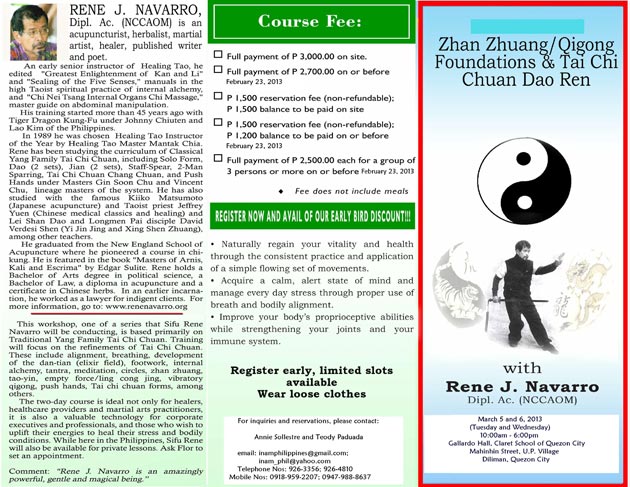
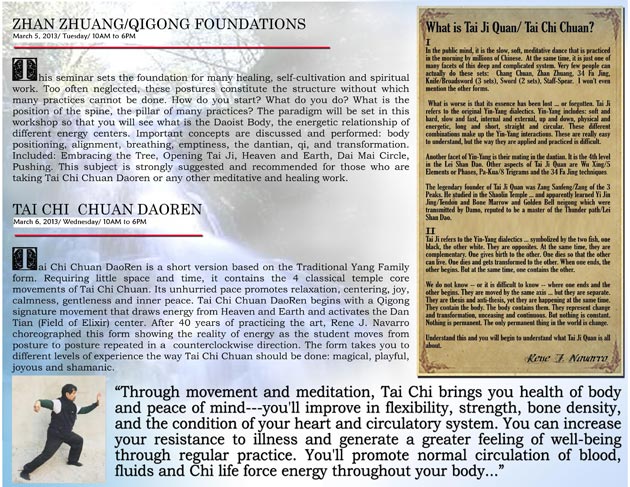
December 21, 3 AM, Foothills of the Appalachian, PA
There are a legion of distractions pulling us one way or another, often different influences/temptations bombarding our senses, that we fail to listen to what is authentic and what is essential. To me, it is important to listen deep, in stillness. Since it is the year of the Water Dragon, the darkness offers the wisdom that we can listen to. The organ at this time in the season is the Kidneys. Their sense openings are the ears … they connect us to the external and internal worlds. While we can listen to the outside world, we can also listen to the internal. Water stands for flexibility and softness and deep wisdom.
One of my father’s favorite words was “meretricious.” It means something — an object, phenomenon, a person, a goal, status or event — that is attractive, sensational and seductive. Something that can turn our heads and make us lose sight of and forget what is truly valuable and genuine. Something that can also make us lose our anchor to our deeper Self, the spiritual and eternal, the flame that burns in our Heart. The Siren Song that pulls us away from our life and destiny.
I have often gone back to the ancient classics of Daoism. I have read them carefully — drank of their wisdom elixir. Simple words but deep and meaningful. Here are three passages — two from the Dao De Jing and one from Zhuangzi.
The masters of this ancient path
are mysterious and profound
Their inner state baffles all inquiry
Their depths go beyond all knowing
Thus, despite every effort,
we can only tell of their outer signs –
Deliberate, as if treading over the stones of a winter brook
Watchful, as if meeting danger on all sides
Reverent, as if meeting an honored guest
Selfless, like a melting block of ice
Pure, like uncarved wood
Accepting, like an open valley
Through the course of nature
muddy water becomes clear
Through the unfolding of life
man reaches perfection
Through sustained activity
that supreme rest is finally found
Those who have the Tao want nothing else
Though seemingly empty
they are ever full
Though seemingly old
they are beyond the reach of birth and death
Chapter 15, Tao Te Ching: The Definitive Edition by Jonathan Star
It mentions virtues that the ancient sages cultivated and how these virtues were applied to certain situations. The passage is actually an affirmation that we can read and memorize. In studying it, we should allow its message to emerge from the waters like a lotus.
At the center of our meditation is stillness. Beyond movement and contemplation, beyond theories and practices, is the subtle and elusive concept of stillness. Since humans are possessed of a Monkey Mind, it is difficult to arrive at stillness, that place of nothingness/ emptiness that no concepts, ideas, ambitions, dreams, achievements, pursuits can reach. It is where we finally find our … Self.
Chapter 16, Dao De Jing: Definitive Edition by Jonathan Star
Become totally empty
Quiet the restlessness of the mind
Only then will you witness everything
unfolding from emptiness
See all things flourish and dance
in endless variation
And once again merge back into perfect emptiness –
Their true repose
Their true nature
Emerging, flourishing, dissolving back again
This is the eternal process of return
To know this process brings enlightenment
To miss this process brings disaster
Be still
Stillness reveals the secrets of eternity
Eternity embraces the all-possible
The all-possible leads to a vision of oneness
A vision of oneness brings about universal love
Universal love supports the great truth of Nature
The great truth of Nature is Tao
Whoever knows this truth lives forever
The body may perish, deeds may be forgotten
But he who has Tao has all eternity
Zhuangzi, Chapter 4. Fasting of the Heart/Xin (modified from Essential Zhuangzi by Hamill and Seaton)
… Yen Hui said, “May I ask what method you’d employ?”
“Fast,” Confucius said, “and then I’ll tell you. But having the method is one thing, carrying it out is another. Will it be easy? Whoever thinks it might be easy is not suited to the job.”
“My family is poor,” Yen Hui said. “I haven’t tasted either meat or wine for months. Is that what you would call fasting?”
“That’s fasting for a sacrifice,” said Confucius. “It is not the fasting of the heart.”
“What is fasting of the heart, then?”
“Set your heart on the One,” said Confucius. “Don’t listen with your ears; listen with your heart. Then stop listening with your heart and listen with your Qi. Hearing stops with the ear, the heart stops with words and symbols. The Qi is empty. Being so, it can attend to all phenomena. Dao begins to roost in emptiness The emptiness is the fasting of the heart.”
December 19, 2012. In the foothills of the Appalachian, PA.
I don’t know what you are going to do and where you’re going to be, but blessings to you and yours on this most sacred time of the year. I will be in NY City December 21, 22 and 23. I leave for the Philippines on Monday December 24.
No, the world is not going to end on December 21, notwithstanding dire and apocalyptic prophecies. Yes, there is going to be a shift in the astronomical alignment, but only to the extent that we are moving to another season (Spring and the return of the Light). No, we do not have to do anything extraordinary (like a pilgrimage to Chichen Itza in Mexico or the pyramids o Giza in f Egypt), but it’s important to be aware of the shift our own body is taking as we slowly move through the seasons. Yes, we should do a meditation to align ourselves to Nature and its transformation. So perhaps on the 21st or 22nd, we should spend an hour or so early in the morning or late at night (preferably at 11 pm to 1 am) in stillness. Since it is the year of the Water Dragon, focusing on the Kidneys and the Water Element would help re-orient us to the 5 Elements (Water, Wood, Fire, Earth and Metal). I will do my own practice. On the 22nd I will also be at Columbus Park in Chinatown at 8 am to practice Tai chi chuan. If you are interested, please feel free to come.
To me, change in the world has to start from within. Self-cultivation practices are important in human transformation. So each and everyone of us has to have a serious meditative, spiritual and/or qigong regimen. It is good to do it with others, a group or community of friends and practitioners. But often we have to do it alone. We have to work on the Heart to be able to see ha any concrete and significant effect out there. Ultimately, society is just a mirror of what happens from within.
May I share some brief notes from my journal at this time of year:
Winter Solstice is associated with the coming of the Light in many ancient cultures. In the I Ching/Book of Change, Hexagram 24, this is depicted as Return/Fu. The Yang emerging from the Darkness of the Yin.
“The Complete I Ching: The Definitive Translation” by Al Huang (Inner Traditions: 1998) says:
“Fu plays an important role in the I Ching. It is one of the twelve tidal gua used to explain the cosmology of the changing of the seasons — to go around and begin again. It represents the eleventh month of the Chinese lunar calendar, or December. According to the I Ching, ‘When Yang turns back, it is Fu.’
“At the Winter Solstice, the twenty-second day of the eleventh month, the yang energy emerges. In Northern China, people can actually feel the yang energy begin to surface at the turning point of that specific day. There is an ancient saying handed over thousands of years: ‘At winter solstice, yang begins to surge.’ This idea is vividly expressed in the structure of the gua. For this reason, during the Zhou dynasty the Chinese New Year began with the winter solstice. The yang energy starts a new cycle.” page 212.
In the Taoist meditative and health exercise of Taoyin (now called Qigong), Winter Solstice is associated with the 5th lumbar vertebra and its activation. Each of the 24 vertebrae in the spine corresponds to a day in the calendar. So a vertebra is covered once every 15 days. Chen Xiyi, a Taoist of the 10th and 11th century CE, who lived on Huashan/Flower Mountain, choreographed exercises. He said that the set for the Winter Solstice should be done between 11 pm and 3 am on the second half of the Eleventh Moon to remedy cases of cold and damp in the jingluo channels and the extremities, lumbar pain, and counterflow qi under the navel/CV8/Shenque. Master Chen is also famous as the founder of Liu He Ba Fa/6 Harmonies, 8 Methods and Sleeping and Dreaming Qigong.
“Ancient Way to Keep Fit” (Hai Feng Publications HK: 1990), page 45.
With David Verdesi (www.david verdesi.com) and other students, I visited the Basilica di San Clemente in Rome 3 times within a period of 1 month 3 years ago. We were training in Lei Shan Dao at the time. Beneath the church were the ruins of the ancient temple of Mithras. There were pillars, a fresh water spring, and most prominently a cauldron-like excavation for bull sacrifice. I did not know anything about Mithras except he was supposed to be a Persian god or prophet. A quick look at the internet showed that he preached love and compassion, had 12 disciples, died and was resurrected on the third day. He was born on December 25 about 500 to 600 years before Jesus.
Here is a passage from a book that I’ve been reading:
“One of the imported religions that was gaining a large following in Rome was the Iranian cult of Mithras. According to legend, Mithras had been sent to Earth by the Supreme God of Light to slay a bull whose blood was the source of all fertility. Only men (most of them Roman soldiers) participated in Mithraic rites. Neophytes were required to undergo baptism and to perform deeds of self-sacrifice and courage, thereby progressing through seven stages of initiation. The process was said to bring about a gradual purification of character, leading finally to the unconditioned state that the soul had known before birth. Having achieved this seventh degree, the initiate was regarded as an incarnation of the divine.
“The central event of the cult myth, the slaying of the cosmic bull, was regarded as the greatest event in the history of the world – the act of Creation at the beginning of time, and of redemption at the end. Believers reenacted the drama in a nocturnal bull sacrifice in a cave or grotto. This ceremony was seen as a celebration of the union of opposites – life and death, spring and autumn, beginning and ending. Sculptures of the bull slaying showed grains flowing from the wound in the animal’s neck.
“Mithras’s birth was supposed to have been attended by shepherds. At the end of his time on Earth, he and his disciples shared a last supper, which was later commemorated by believers in a communion of bread and wine. Furthermore the hero was said not to have died but to have returned to heaven, and his followers believed that he would come again at the end of the world. Then the dead would rise from their graves for a final judgment.
“The Mithraic holy day was Sun-day, a fact no doubt noted by Emperor Aurelian, who, with so many of his soldiers being initiated into the Iranian cult, must have wondered: Why not consolidate the worship of Mithras with that of Sol Invictus? Accordingly he declared December 25th the official birth festival not only of Sol but of Mithras as well.
“By the fourth century, a radical Jewish sect calling themselves Christians was brewing trouble for the Roman authorities. The Emperor Constantine, realizing the best way to defuse the movement might be to co-opt it, made Christianity the state religion with himself at its head. The Christians went along, though doing so entailed a few revisions to their rites and beliefs. Previously their Sabbath was Saturn-day; but for unity’s sake, Constantine changed it to Sun-day, the feast day of both Sol and Mithras. This was acceptable to Christians since, after all, Christ’s resurrection had occurred on a Sunday, the day after the Jewish Sabbath (Saturday) following the Passover.
“Moreover, within another quarter of a century or so (by the year 360, certainly) the December 25 feast-day of Sol and Mithras had become the principal Christian festival as well, the day for the commemoration of the birth of Jesus. This date met with the approval of Christians because, first of all, no one knew Jesus’s real birthday anyway; and second, the winter Solstice had always been seen as a time of renewal. It was the time of the rebirth of the Sun and of light. Therefore how fitting to use it as the day to celebrate the birth of the true spiritual light of the world! And, even though the Solstice ceased to occur on December 25 centuries ago due to calendrical inaccuracies, Christians have celebrated Christmas on this day every year since.”
“Celebrate the Solstice: Honoring the Earth’s Seasonal Rhythms through Festival and Ceremony” by Richard Heinberg (Quest Books: 1993), page 104.
I was in Mexico a few times in the mid-80s. These photos were taken at the Chichen Itsa Mayan pyramid complex. There’s the pyramid of Kukulkan, the cenote/sacrificial pool, the observatory and the leopard inside the pyramid.
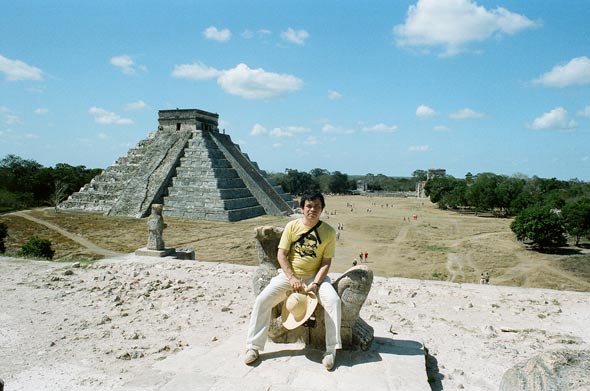
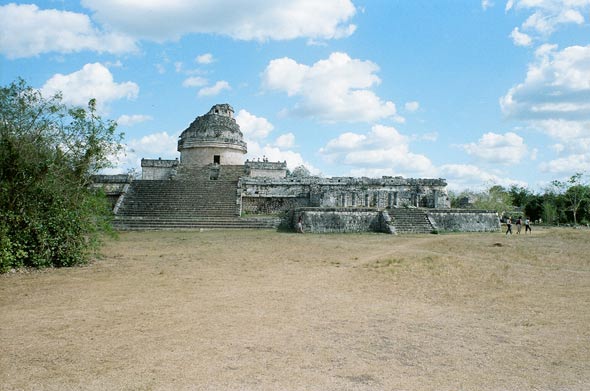
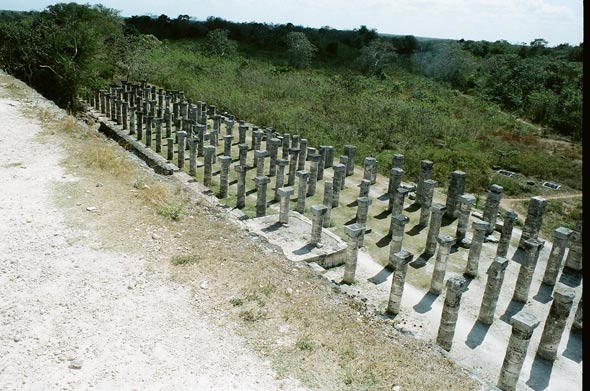
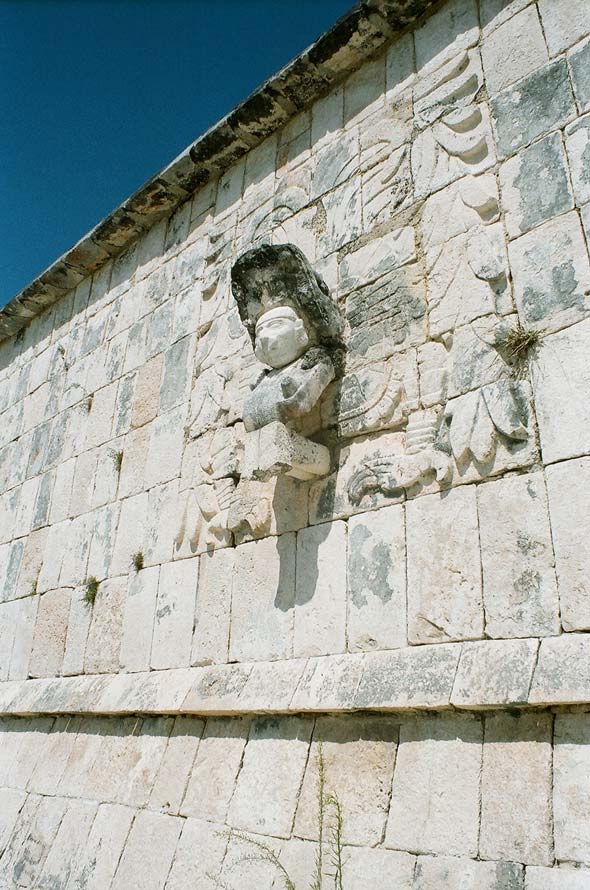
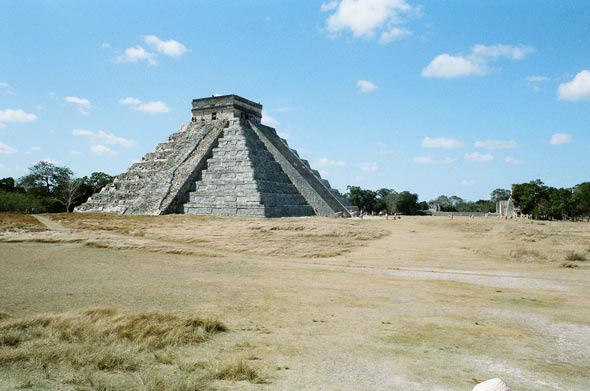
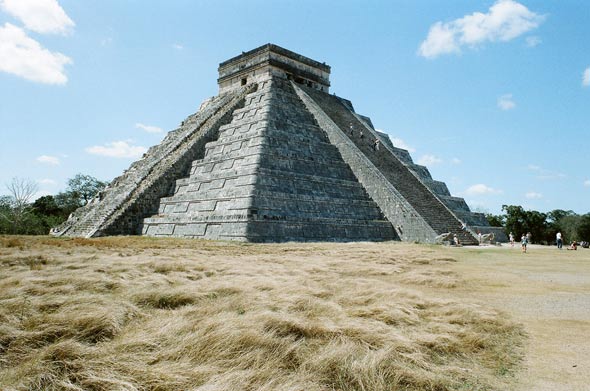
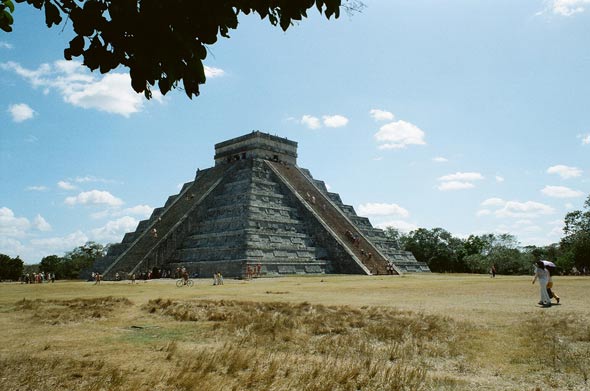
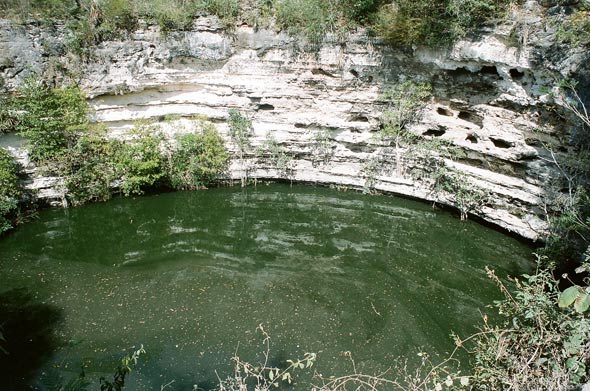
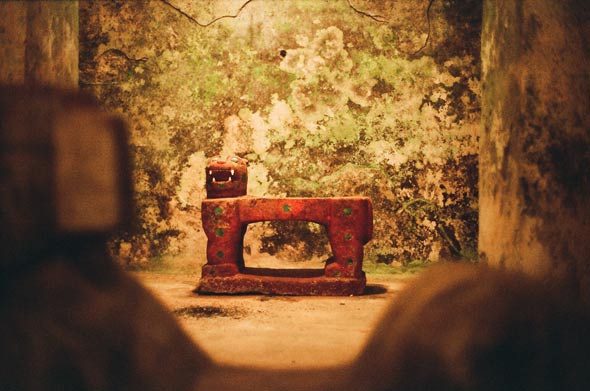
It was in the Winter of 1994 — I have to consult my diary about it — and enroute to Hawaii from the Philippines, the plane stopped over at Narita in Japan. I was with a couple of Chinese women I met in Hongkong. (Our United Airlines flight was delayed for a whole day in HK because of a terrorist report. I’ll tell you the story another time.) We had a whole day to kill, so we decided to take a train to Tokyo and walked around. We were not dressed for the cold weather. I saw this park and did Tai chi there, something I have done in many parks around the world. The women took a few photos of me. We eventually landed in Oahu, Hawaii. It turned out the Chinese women were going to spend a few days at the University of Hawaii in Manoa. I took them around the island. Another coincidence: we met again in Harvard University a week or two later. (There is no space to follow the thread, so I’ll also reserve it for later.) Perhaps, life has a lesson or two to teach us when we encounter synchronicity. Perhaps it is just happenstance — random, incomprehensible events that have no meaning?
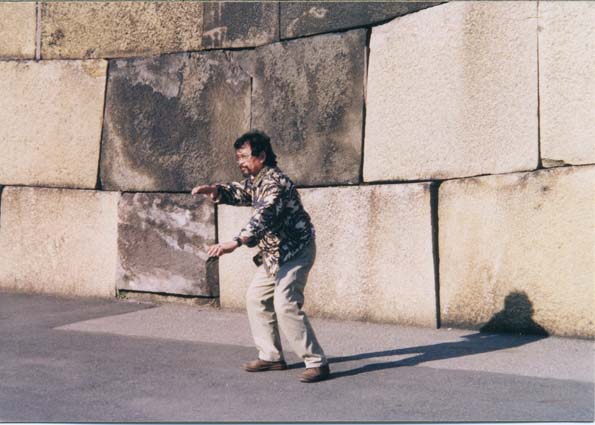
In the outskirts of Hangzhou are the tea plantations and the temples. Some of the buddhas were carved on the mountainsides. I have been to Hangzhou a few times. To me, it is the most interesting city in all of China. I spent many memorable hours doing Tai chi inside a walled garden devoted to bonsai on Xihu/West Lake. You paid for a flask of hot water and a spoonful of tea and you sit on the patio. Because there is an entrance fee, there aren’t many practitioners of Tai chi there, so you can actually have the place to yourself for hours. If you arrive early enough, there are no guards and you can come in for free. Within walking distance there’s Hefang, a street with old wooden houses. The place is a kind of mall with shops vending tea, scarves, paintings, decor, gourds, buddhas, wu-shu weapons, clothes, bags. There’s a food court on one side selling delicacies of the city — Su Dong Po pork, West Lake carp, duck bills and feet, stinky tofu. There’s also near the entrance a couple of massage centers run by the blind.
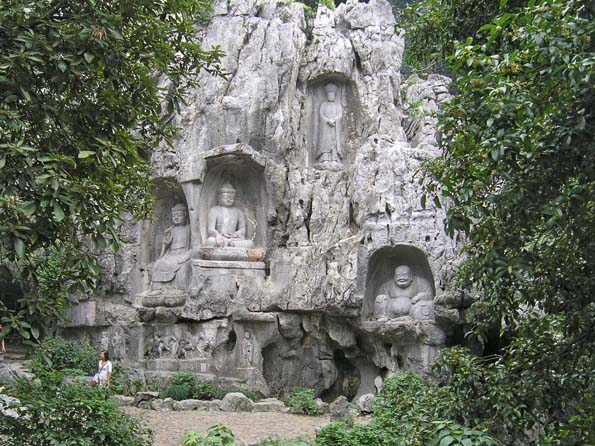
My birthday celebrated with the family at one of my favorite restaurants, the Seoul Garden, on E 32nd Street and Broadway in Manhattan. With my granddaughters Ava and Isabel. Seoul Garden has some of the best doufu in town. I’ve celebrated several of my birthdays there.
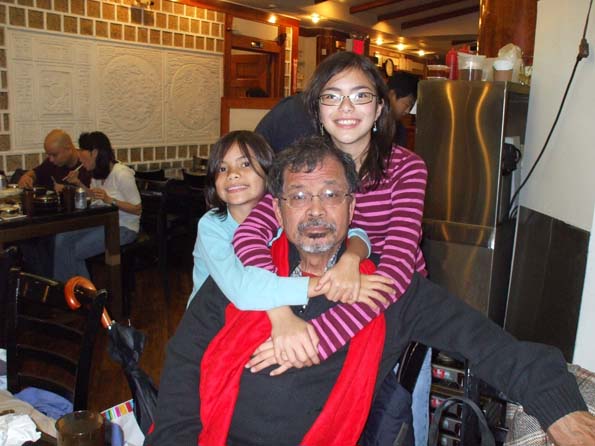
I make it a point to go to Walden Pond every time I go to Boston. I often do Tai chi in the parking lot in the summer or by the water in other seasons. The guards do not bother me; they just tell me to practice farther from the weekend traffic, especially when I have my Dao/Knife and Jian/Sword. After practice, I walk around the lake, stop by the original location of Henry David Thoreau’s cabin and light an incense or two there.
One time, in observance of Spring Equinox, on a Sunday I went to Concord and spent a couple of hours sauntering around Walden Pond, where Henry David Thoreau lived for a couple of years in his famous cabin. Sauntering: from sainte terre, now meaning a pilgrimage to a sacred place.
I have done it many times before, especially during my years studying and later teaching in acupuncture school outside of Boston. There were occasions at Walden when I practiced Tai chi chuan for hours at The Farm with my friend Debra Kang Dean, an award-winning poet and Tai chi teacher and aficionada (www.debrakangdean.com). Her late husband Bradley Dean was a respected Thoreau scholar.
I almost always end up at the original location of Thoreau’s cabin where a cairn has been built nearby. A sign was posted saying (from Walden, or A Life in the Woods):
“I went to the woods because I wished to live deliberately, to front only the essential facts of life, and see if I could not learn what it had to teach, and not, when I came to die, discover that I had not lived.”
I did repair to the store on the premises and bought a few memorabilia: a couple of items with Thoreauvian quotes:
“Surely joy is the condition of life.”
“Always you have to contend with the stupidity of men.”
“Simplify. Simplify.”
I also got some cards with the famous line:
“If a man does not keep pace with his companions, perhaps it is because he hears a different drummer.”
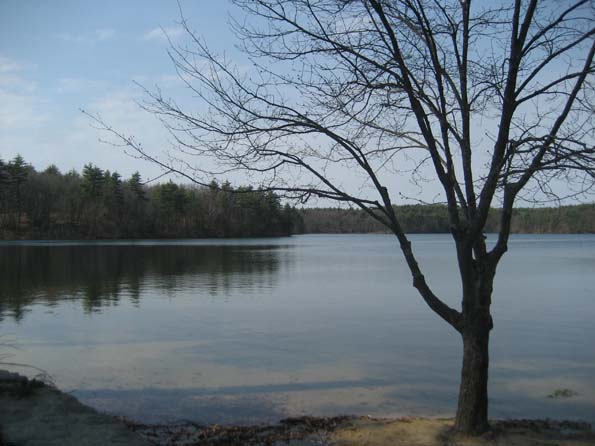
At Fengdu, the city of the dead. The cruise ship stops at different points on the trip to the 3 Gorges and the Great Dam. There were vendors peddling memorabilia, umbrellas, masks, snacks, bottled water. Inside there were statues of people undergoing punishment in the different circles of hell.
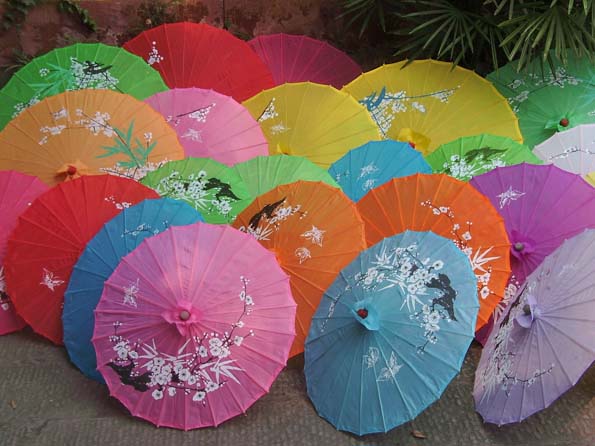
I was in Paris a long time ago. I practiced Tai chi at the Jardin de Tuileries before I went to the Louvre to see the Mona Lisa and the Winged Victory of Samothrace, two of my favorite art objects in the museum. I cannot remember now if I.M. Bei’s pyramid was already in place at the time, but somehow in my memory, it has always been there during the times I was visiting. In the photo, I posed in the White Crane posture.
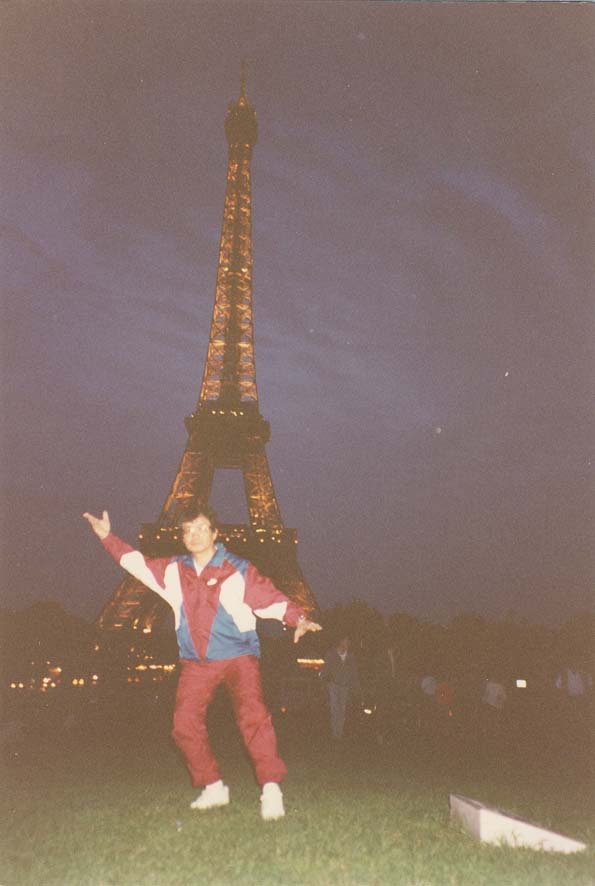
If you are at the Tao Garden, GM Mantak Chia’s first-rate resort in Doi Saket, Chiangmai, Thailand, be sure to take a walk around the village. There are temples where you can listen to the monks chanting early at dawn, a noodle shoppe run by the thoughtful and lovely Pilat, and a few arts and crafts stores. These giant tamarind trees in the photo have their own spirit house and a small chapel for pilgrims. And oh, yes, don’t miss the coconut ice cream in a private house across the creek. It is the best ice cream I have had anywhere. We often snuck up to the freezer at night and helped ourselves, always leaving the payment on the table.
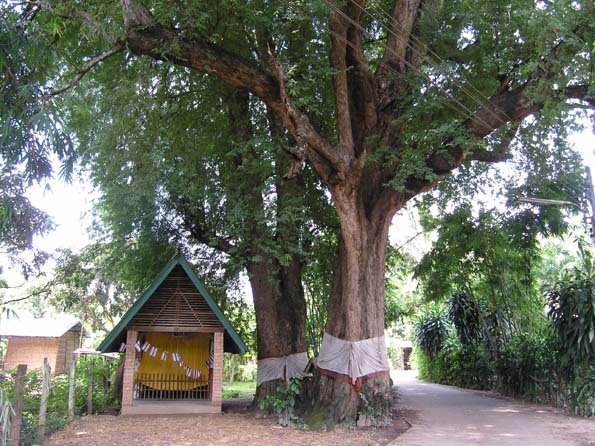
A viewing window at the Humble Administrator’s Garden in Suzhou, the Venice of the East. One time when I was visiting, there was a small ensemble playing traditional music on traditional instruments like the zheng/zither and the pipa/lute. Easy to be transported to the past in these surroundings.
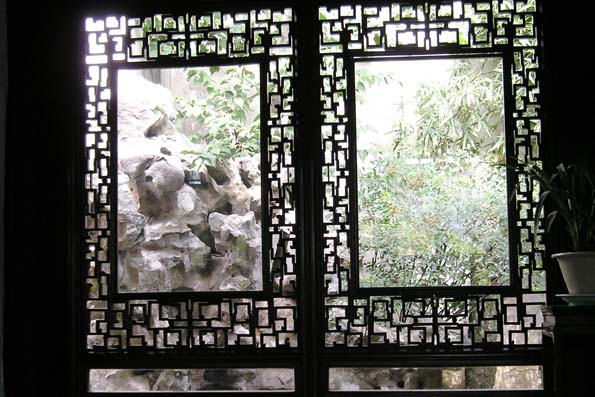
My first time in Chichen Itza, near Tulum and Cancun, was in 1984. I had been there many times in the 80s. I guess that was before the New Age people discovered the place. Nowadays, it is a center of pilgrimage for thousands during the equinoxes and solstices. One of my memories is seeing the serpent crawl down the steps. Since then, there have been much research into the different pyramids. It is amazing how much esoteric information is encoded in them.
